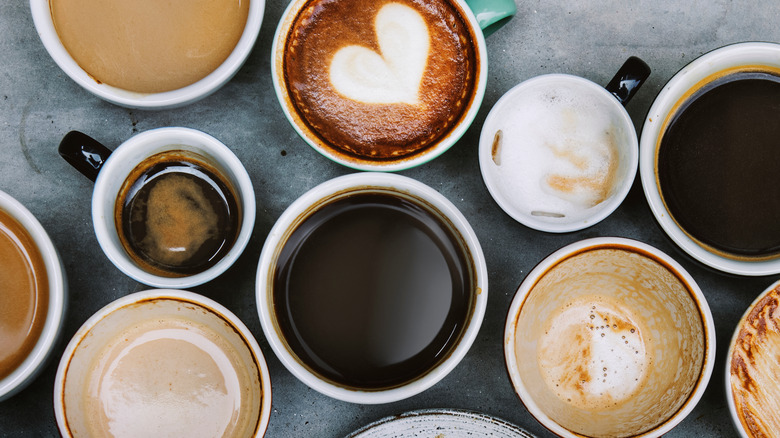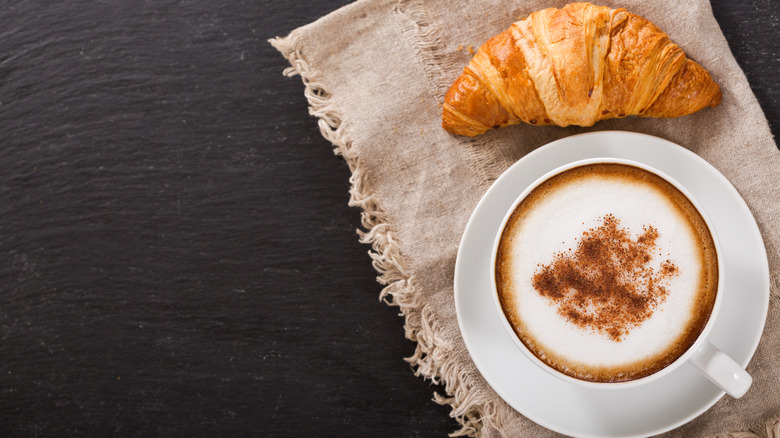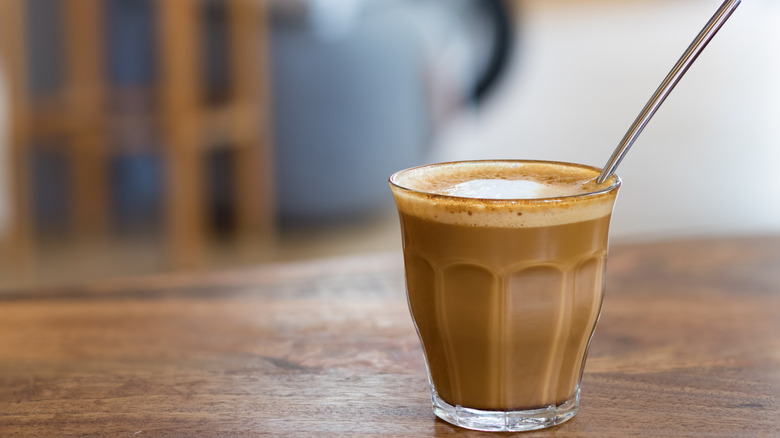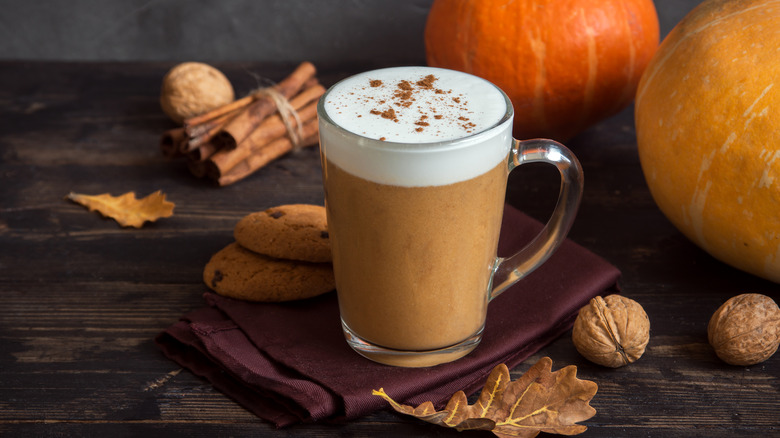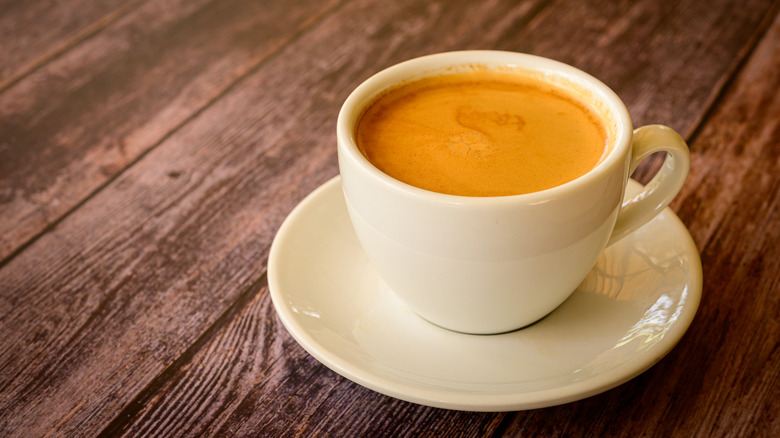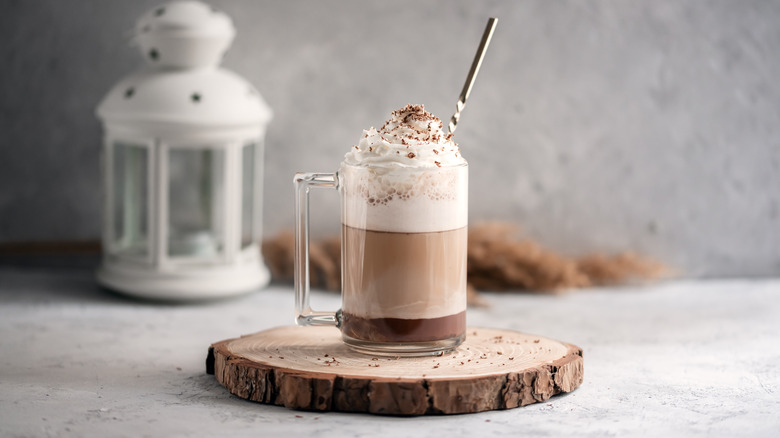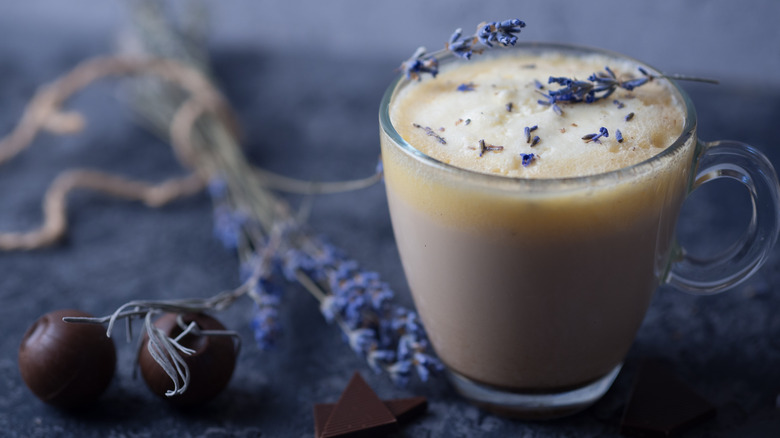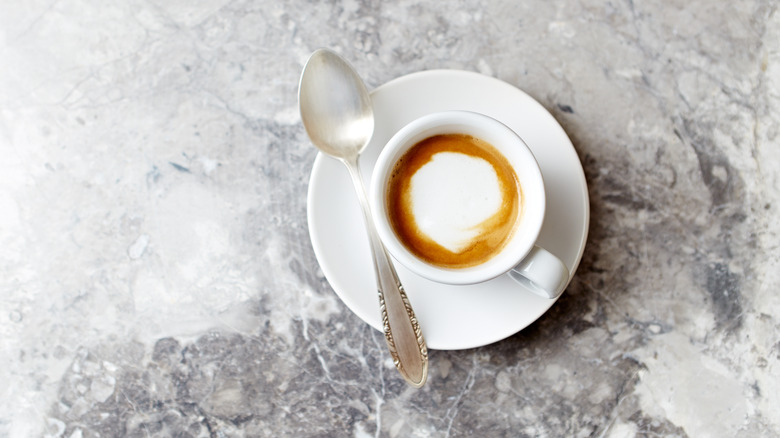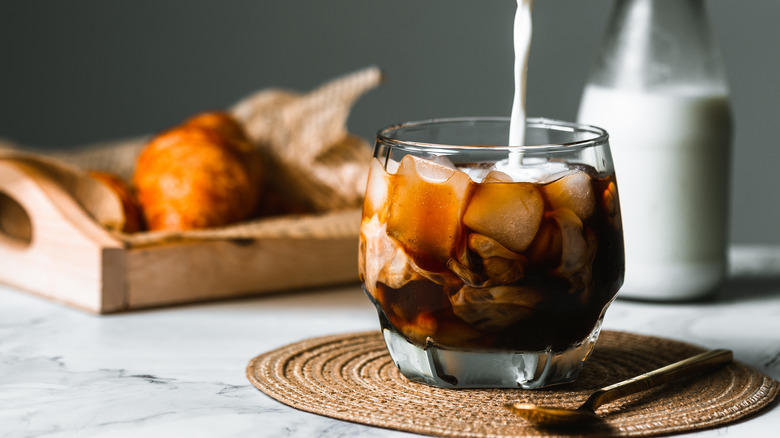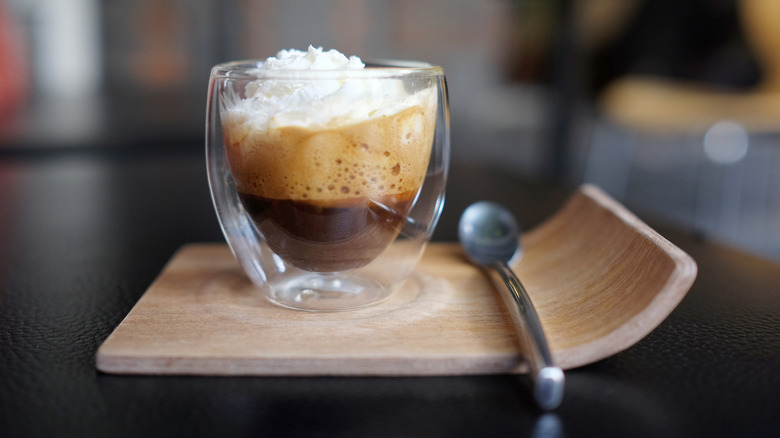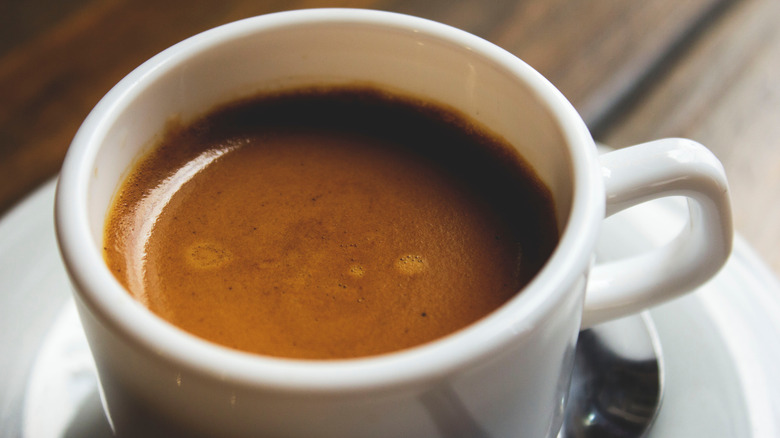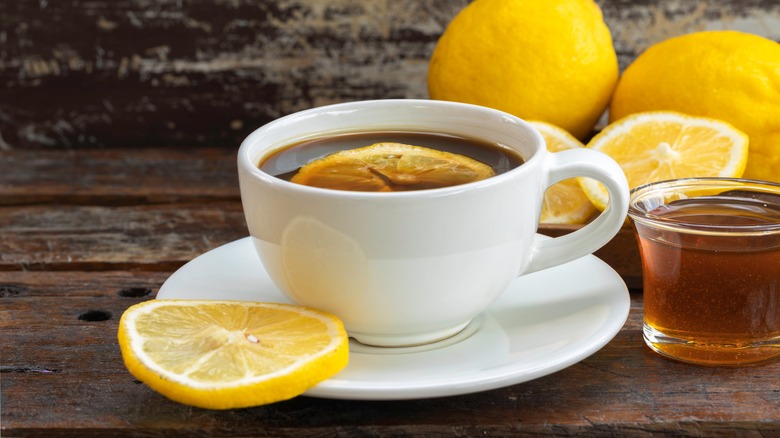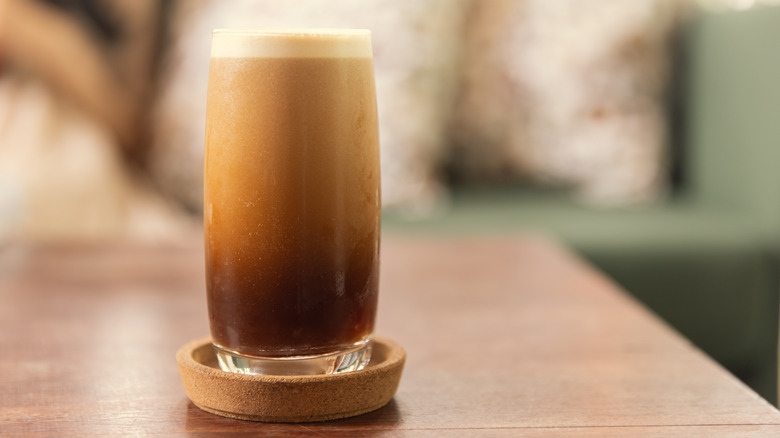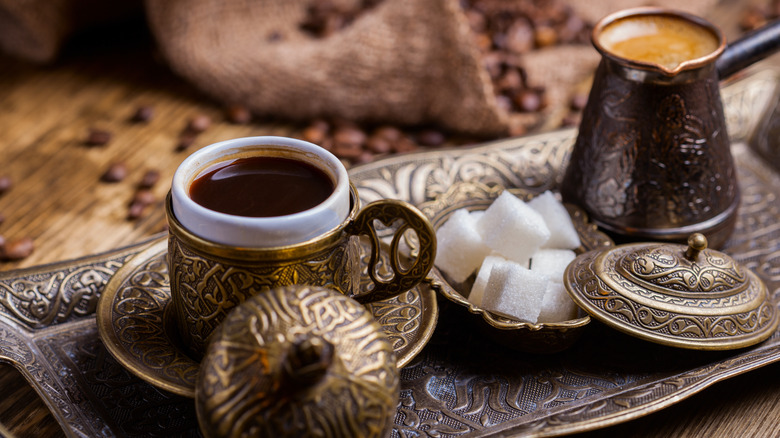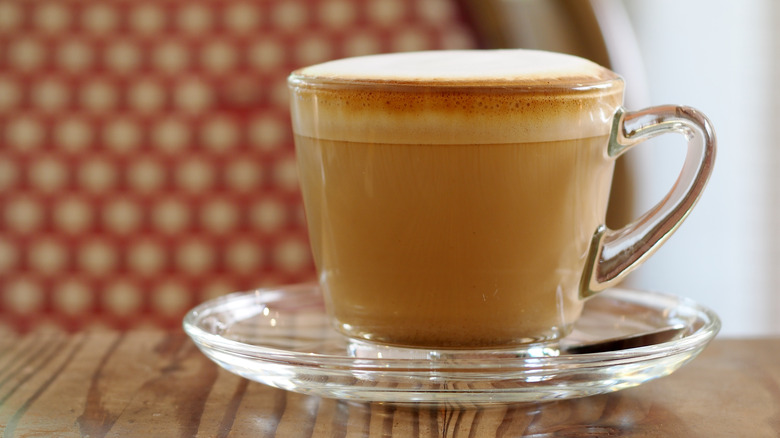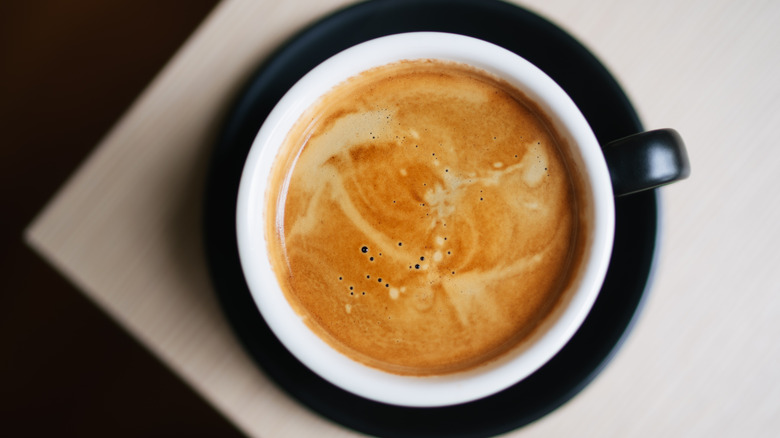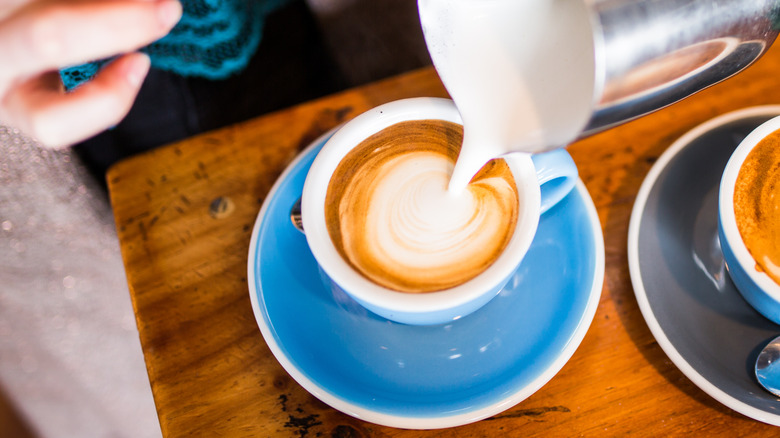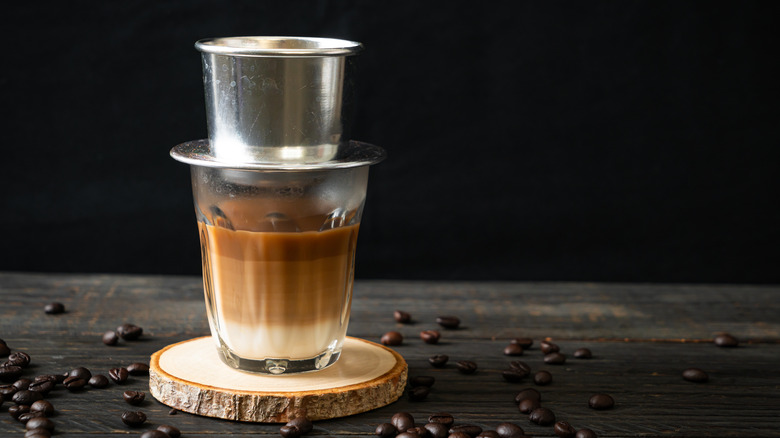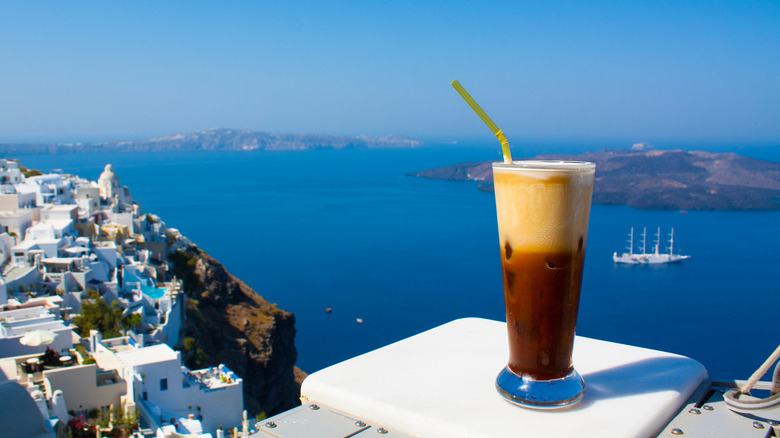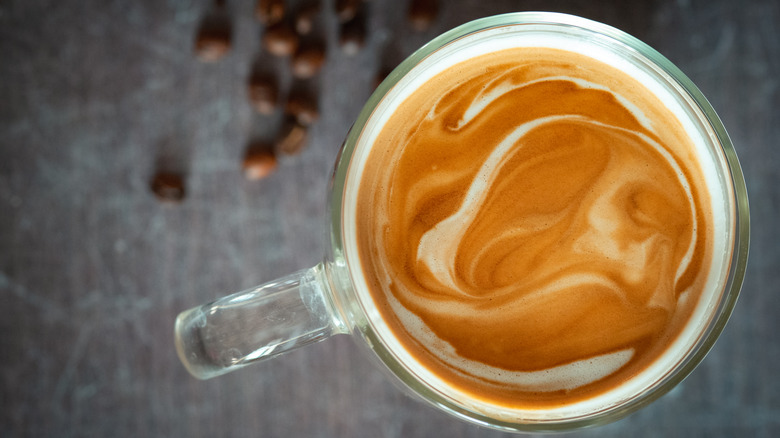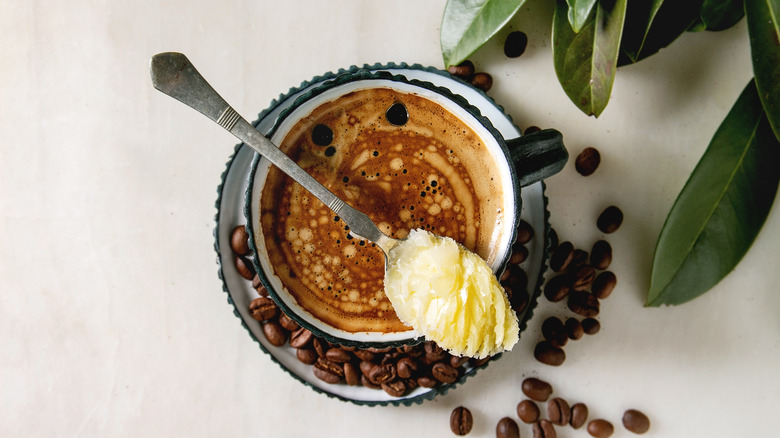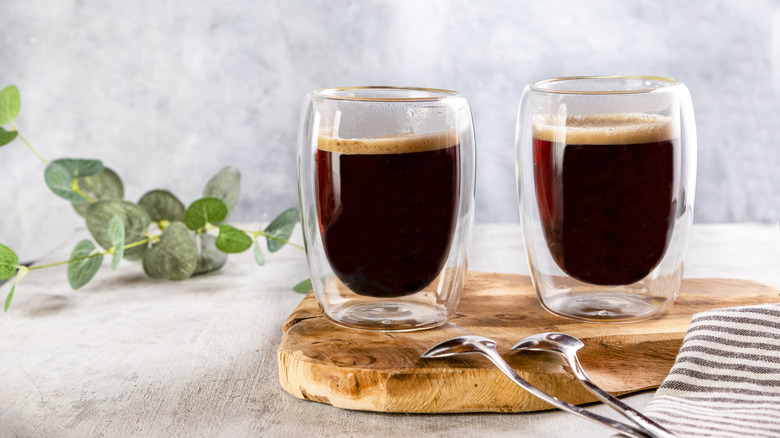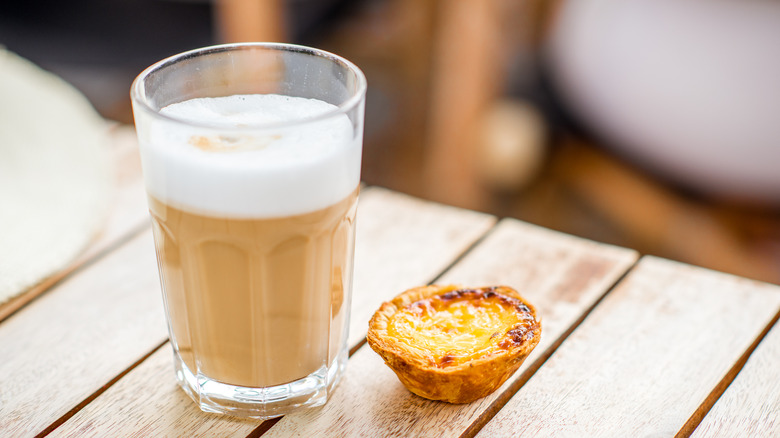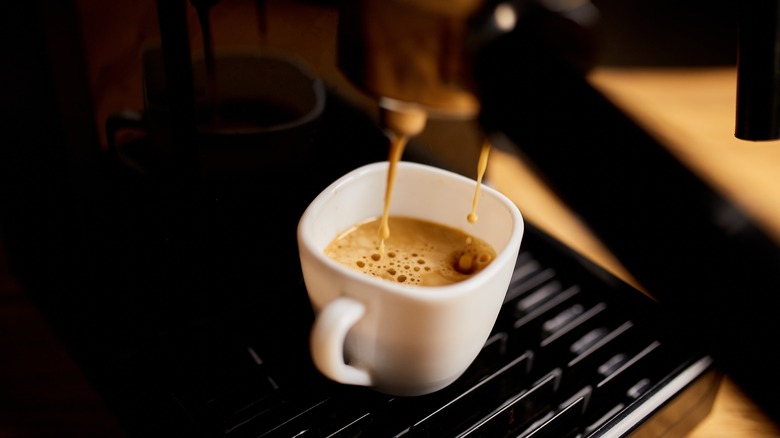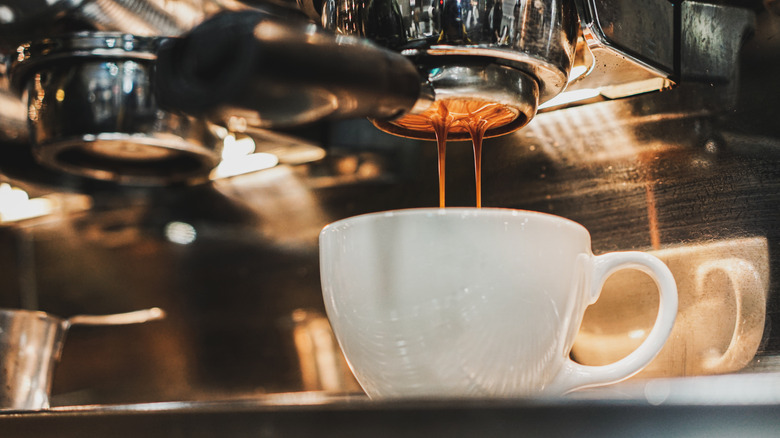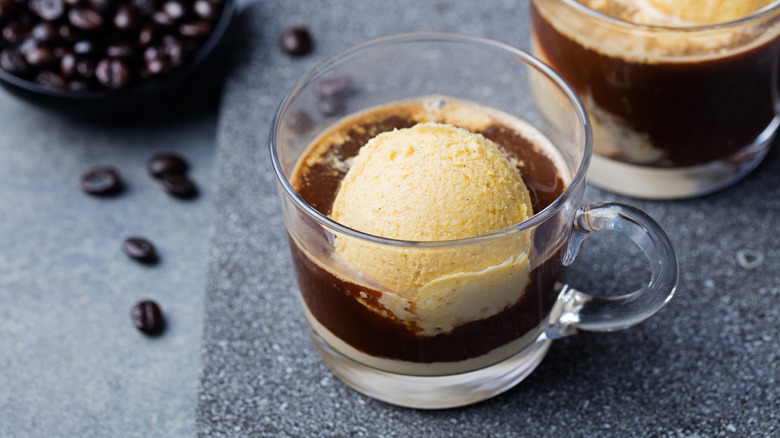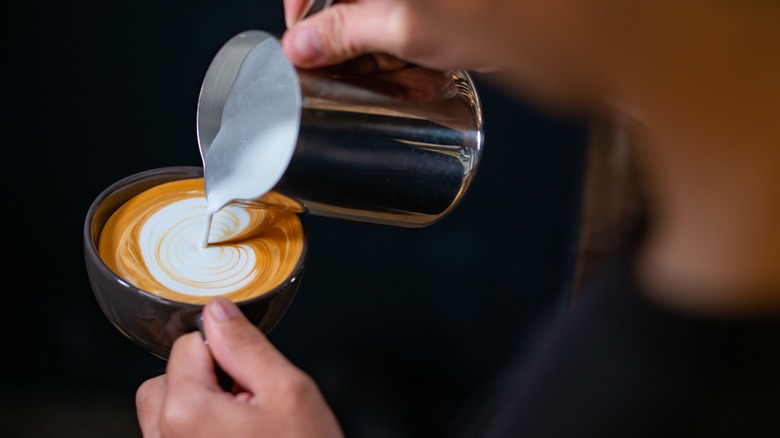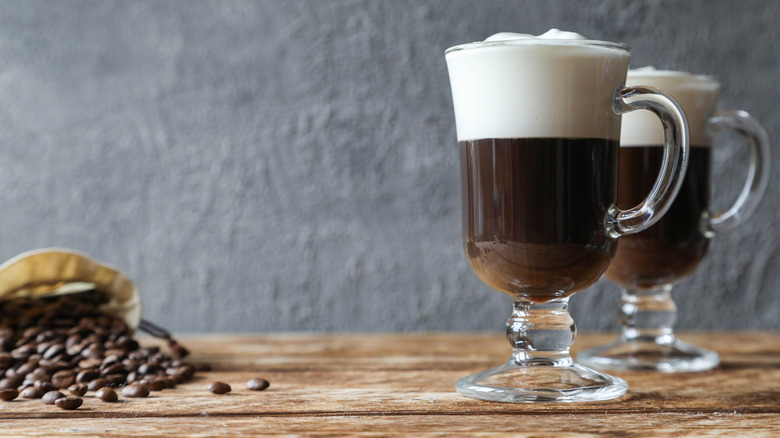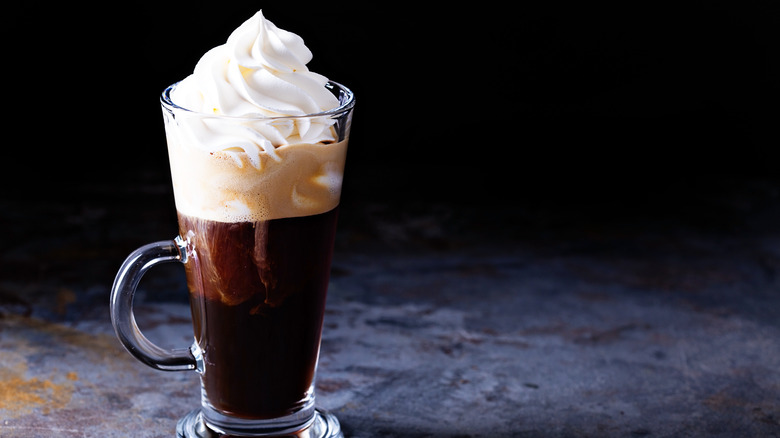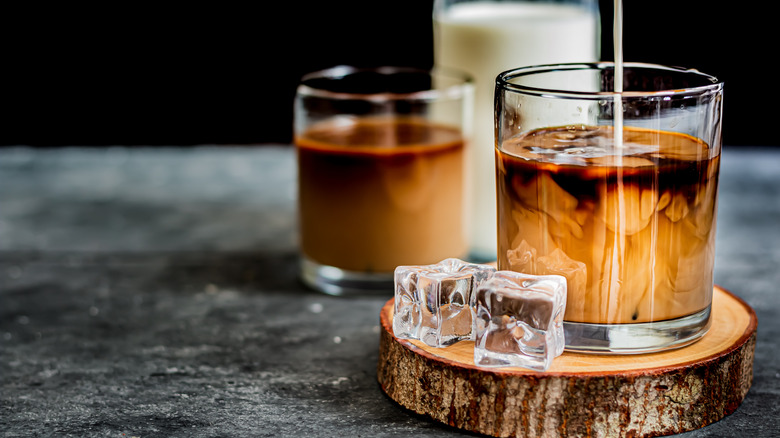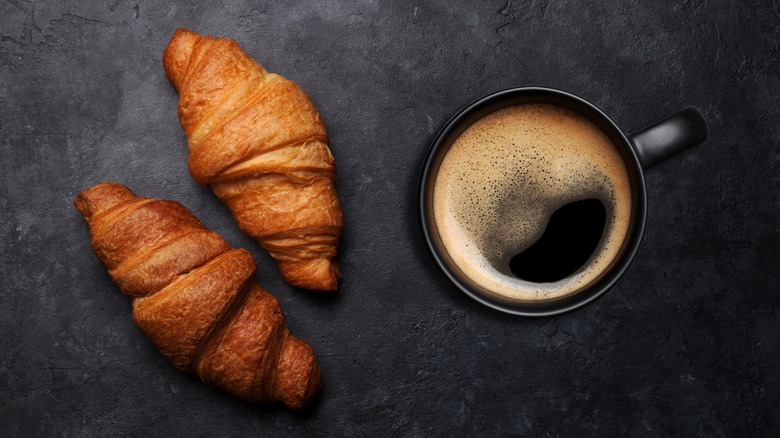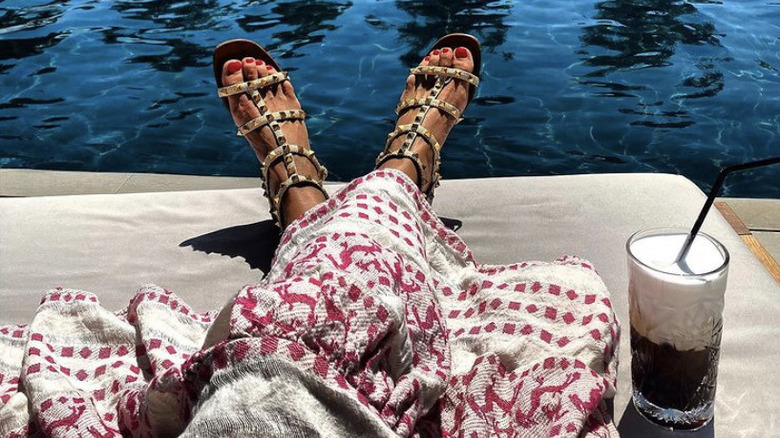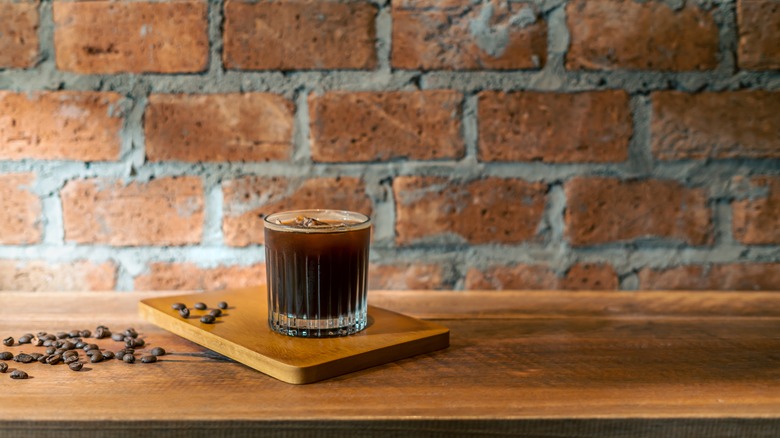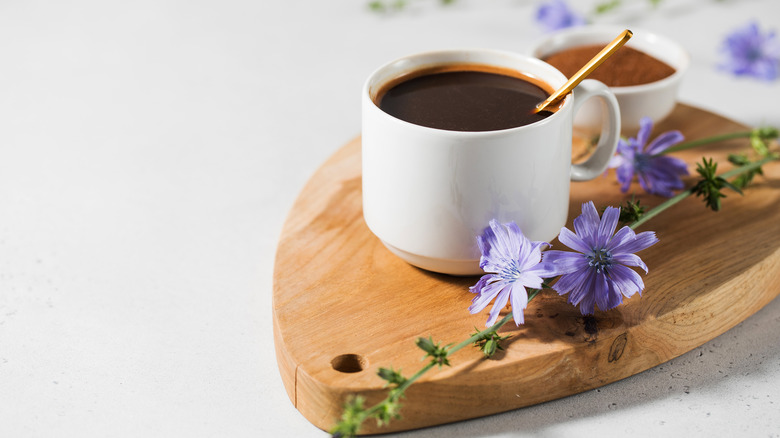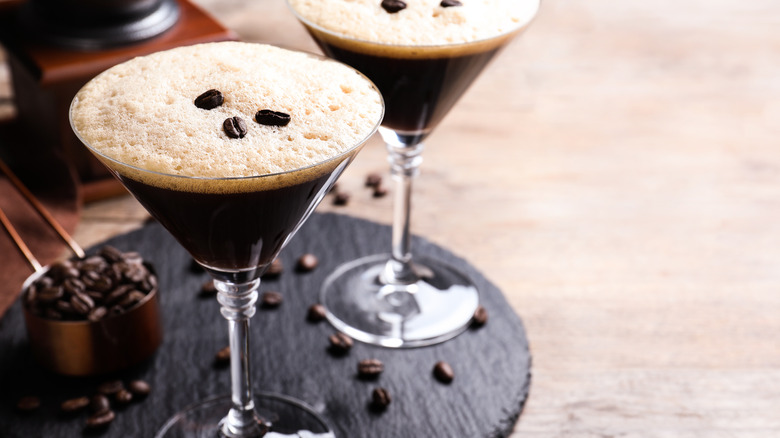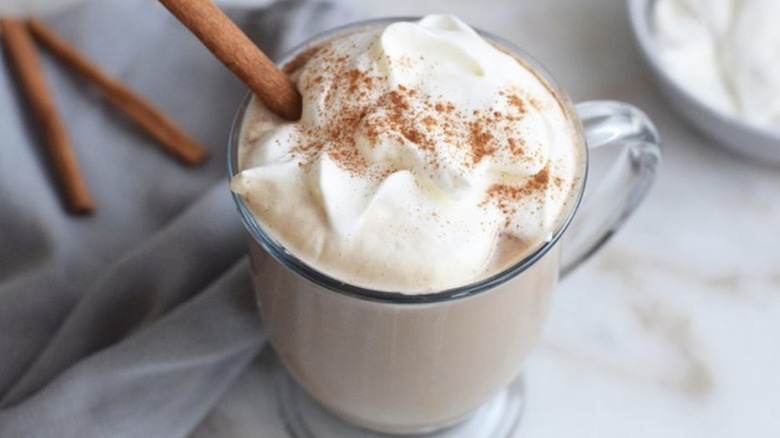35 Different Types Of Coffee Explained
We may receive a commission on purchases made from links.
No one knows who discovered coffee first, though it is widely believed that the bean's origin can be traced back to Ethiopia. According to the National Coffee Association, a popular legend claims that it was a goat herder by the name of Kaldi who found that chewing on a particular berry filled his goats with energy and kept them up at night. It was under the Ottoman Empire in the 16th century that the Ethiopian discovery was introduced to the Arabian Peninsula as an alternative to illicit alcohol (via The Atlantic).
From there, coffee was introduced to Europe. Here, the Atlantic writes that it was first viewed as the "bitter invention of Satan" till Pope Clement VIII himself took a sip of it and gave coffee his stamp of approval: "This devil's drink is so delicious ... we should cheat the devil by baptizing it," he is claimed to have declared. What started as an accidental discovery by a goat herder has now turned into a drink that millions over the world regularly depend on, albeit in different forms.
Although all types of coffee begin with coffee beans, the drink can be brewed using different kinds of equipment. Many countries also have traditional methods of brewing the drink, to which varying ratios of liquids and flavorings can be added. The mix and match of brewing methods, flavors, and drinking traditions mean that there exist a zillion types of coffees in the world, of which this list explains some of the most common ones.
1. Cappuccino
Now a famous Italian coffee, cappuccino is an espresso-based java that comes from an Austrian drink called kapuziner (via Super Coffee). Inspired by the dark color of robes worn by Kapuzin friars of Austria in the 1700s, kapuziner was made with coffee, milk, sugar, and a swirl of whipped cream on top. What we now know as cappuccino, Perfect Daily Grind explains, was concocted by Italians in the 1900s for whom cappuccino was the ideal morning coffee that could be drunk in a handful of gulps for a quick jolt of caffeine.
While the exact method to making a cappuccino differs between leading coffee institutions of the world, Super Coffee writes that a 1:1:1 ratio of espresso, steamed milk, and foamed milk is generally followed in the U.S. That is, a cappuccino is usually one-third espresso and one-third steamed milk, followed by one-third of creamy milk foam on top. Per Daily Perfect Grind, when brewed by a skilled barista, the steamed milk and milk foam will form layers over the espresso instead of blending into it. The layers are the biggest giveaway that visibly distinguishes a cappuccino from other milk-based espresso coffees. This is also why a cappuccino usually tastes more intense than its milky counterparts and highlights the flavor of the coffee beans much better whilst giving a creamier mouthfeel.
2. Cortado
The origin of this espresso-based coffee can be traced back to Spain's Basque County, where cortado was given its name after the Spanish verb cortar, meaning to cut (per Perfect Daily Grind). A smaller version of a cappuccino, Roasty Coffee says that a cortado has just enough milk "to cut" the espresso and its acidity.
Equal parts of milk and espresso are used to brew a cortado. As Roasty Coffee reports, the milk, although steamed, has little to no foam. While the lack of froth means that cortado isn't as creamy as other coffees that use foamed milk, it also means that the steamed milk will blend smoothly into the espresso without forming layers. According to Bon Appétit. This makes cortado a very balanced coffee, only a small amount of milk allows the flavors of the espresso to shine without being too intense or milky.
Traditionally, you will find a cortado served in a small metal or glass tumbler and it usually lacks any latte art on top. While most coffees come in different sizes, a cortado is a drink that is meant to be small, and so is almost always served in one standard size even at famous coffee chains.
3. Latte
Although cappuccino has Austrian roots, sources are clear that Italians popularized the foamy drink in the 1900s. Latte, on the other hand (though Italian in origin) was not meant for Italians to drink at all! According to Coffee Bros., the caffè latte was invented in 1867 for American tourists in Italy for whom the Italian cappuccino was too strong a coffee. Consequently, the latte was fashioned to be a less intense and considerably more milky version of a cappuccino for not-so-strong coffee-loving Americans.
Typically, a latte is served in a glass as opposed to a mug and contains mainly espresso and steamed milk with only a thin layer of foam on top, per Coffee Bros. Because of the high quantity of milk — which is more significant than most espresso-based drinks — a latte tends to mask the flavor of the espresso well, making it a solid option for anybody who doesn't much care about the flavor of coffee and only wants it for its caffeine kick. Furthermore, Coffee Bros. writes that the milky taste of a latte, which has only a mild hint of espresso, also explains why lattes are perhaps more popular than any other hot coffee when adding all sorts of syrups and flavors.
4. Red Eye
If the name doesn't already give it away, the red eye coffee is named after a red-eye flight that flies across countries through the night and often leaves travelers with red eyes from exhaustion (via Trade). Unsurprisingly, the red eye is a very, very strong drink. Unlike most other coffees that blend the source of caffeine with water, milk, or other non-caffeinated mix-ins, the red eye combines coffee with ... more coffee.
Originally a secret menu item at Starbucks, Trade writes that red eye coffees can now be found everywhere. The drink is essentially just a cup of regular drip coffee but with the addition of a shot of espresso on top. The taste of a red eye coffee is often compared to an Americano, except it has more body. Although the coffee is intense, Trade finds that the sweet flavor of drip coffee works well with bitter espresso.
While the red eye usually adds one shot of espresso to drip coffee, A Couple Cooks notes that stronger versions of this already-strong coffee exist too. A black eye uses two espresso shots with its drip coffee, whereas a green eye or dead eye uses three. If there was ever a coffee to help pull through an especially sluggish day or a long all-nighter, something stronger than a red eye is going to be hard to find.
5. Mocha
For a long time, mocha or moka referred to a type of Arabica coffee bean grown in Yemen and was used as a blanket term for coffee beans imported from Yemen's port of Al Moka — the place after which the bean was named (via Coffee Or Die). The mocha beans were famous for having a green and yellow tint compared to their brown-colored counterparts. The mocha's iconic association with chocolate also begins here, as the beans were thought to have a distinct, chocolate-like flavor, writes Coffee Or Die.
The modern mocha as we know it today comes from a drink called bicerin, which was popular in 18th century Italy. According to Sprudge, the drink was called after an Italian coffee house by the name of Caffè al Bicerin, which served its customers a beverage of coffee, cream, and chocolate. At the time, Caffè al Bicerin served the three ingredients separately to the café's patrons, who could then mix them as per their taste, per Sprudge.
Even today, mocha is made from similar layers of espresso, milk, and chocolate. The chocolate can be dark, milk, or white and can be added in various forms, including chocolate powder, syrup, and even just melted chocolate (via Super Coffee). Sometimes, a single mocha can even have multiple sources of chocolate! Although the exact method in which a mocha is prepared differs between baristas — whether they add milk froth or not, the kind of chocolate that is used, and how the three ingredients are mixed — one thing remains the same: the luscious mix of milk, chocolate, and coffee!
6. Raf
According to popular legend, Raf coffee originated in mid-1990 Russia when Rafael Timerbaev walked into a Coffee Bean outlet asking for a "good cup of coffee with milk" (via Sprudge). Taking his simple request in good spirit, the barista steamed together a concoction of cream, 2 tablespoons of sugar, and a shot of espresso. The drink became such a hit with Rafael (and other patrons), that Coffee Bean simply added the drink to its menu and named it Raf after its creator.
Through the years, baristas played with the recipe till they came up with one that is famous today. Sprudge defines it as a shot of espresso, a tablespoon each of plain sugar, vanilla sugar, and then a splash of cream. Instead of layering the ingredients one after the other in a cup, they are steamed together in a pitcher and served. The result is a super silky and glossy coffee that is on the sweeter side. The Barista Institute compares Raf coffee to the taste of a drinkable vanilla ice cream, except that it has the additional flavor of coffee as well. Some coffee shops also add syrups and spices to the creamy coffee, and a certain Lavender Raf is particularly popular.
While Raf is rarely ever found outside Russia, the sweet coffee can easily be made at home using either a shot of espresso or a coffee brewed in a French press. All you need with the coffee is some cream and vanilla sugar!
7. Macchiato
If you like a robust milk-based espresso coffee, your go-to drink of choice is likely the good ol' cappuccino. A macchiato, however, is even stronger. According to Roasty Coffee, while a cappuccino was designed to be consumed as a morning coffee, a macchiato is meant to help power through afternoon slumps. Comparable only to straight-up espresso in its intensity, macchiato gets its name from the Italian word for stained or marked. True to its title, when making a macchiato, just enough milk is added to a shot of espresso to effectively "stain" it.
In simple terms, a macchiato is a shot of espresso with just a dash of milk to mellow its intensity. In fact, Cru Kafe claims that a macchiato has the highest ratio of espresso to milk than any other coffee made from the two ingredients, with only a tablespoon or two of foamed milk added to a shot of espresso. Although Italy Explained writes that milky coffees are usually not preferred for post-meal caffeinated digestifs in Italy, Eataly clarifies that an exception is made for caffè macchiato because it's considered to be mostly an espresso anyway. The drink is even served in an espresso cup!
While this style of macchiato is often called an espresso (or caffè) macchiato, there exists a version of a latte macchiato too. This, however, is the complete opposite of an espresso macchiato wherein steamed milk is stained with a shot of espresso instead of the other way around, per Eataly.
8. Cold Brew
No matter the brewing method — espresso machines, drip, or pour-overs — all hot coffee is brewed by steeping coffee grounds in hot water, per Uno Casa. To make iced coffee, saturated grounds are cooled with the help of ice. Cold brew, however, is one of the rare exceptions that does not use hot water or ice to brew. According to Bean & Bean Coffee, the cold brewing technique can be dated back to the 1600s when people in Kyoto, Japan, steeped tea in cold water. Soon after, Dutch trading ships swapped the tea with coffee to find a way of brewing the beverage without the use of open fire.
Today, cold brew is made by steeping coffee grounds in cold or room temperature water for at least 12 hours (via Greatist). Over time, the caffeine, oil, and sugar from the grounds seep into the water to produce a refreshing coffee that is smooth in taste. Hot water tends to bring out the acids from a coffee, making it astringent and often requiring milk to undercut the unpleasant flavor. Because cold brew is made without hot water, Bean & Bean writes that the drink is relatively low in acidity and milk added on top only makes the coffee smoother. Additionally, Greatist notes that iced coffee requires the use of ice, which melts and dilutes the coffee's taste. Cold brew, on the other hand, packs the full punch of a coffee without diluting any flavor.
9. Espresso Con Panna
There are two things that humans love most: coffee and dessert. Oftentimes, the two are even mixed together — take the sugary Raf coffee, for example, the chocolate forward mocha, or even an affogato, which calls for a hot espresso poured over a scoop or two of ice cream or gelato. Espresso con panna is another beverage that makes the best of caffeine and sugar.
Translating to coffee with cream in Italian, an espresso con panna has only two ingredients: coffee and cream (via Jayarr Coffee). Espresso con panna is a shot of espresso served with a swirl of whipped cream on top. Often confused with the famous Viennese coffee that uses espresso, chocolate, and whipped cream, according to Jayarr Coffee, espresso con panna has a contentious origin despite its Italian name. Some claim that the sweet coffee might even have Turkish heritage, as it is customarily served in the small demitasse cup often used for Turkish coffee.
Next time you're in need of a quick caffeine kick but would much rather prefer something sweet, you may want to consider brewing a shot of hot espresso and ditching the sugar for a dollop of whipped cream on top!
10. Café Cubano
Cuba's café cubano may pass in appearance as an Italian espresso, but the two cups of java couldn't be more different. Instead of an espresso machine, a café cubano is brewed using a stovetop espresso maker called cafetera moka (via Britannica). To produce the foamy layer on top called espuma — similar to the crema that an espresso machine produces — Brittanica notes that the first few drops of coffee are beaten together with demerara sugar in a cup. Once the espuma forms, the rest of the brewed coffee is poured over it. The result is a thick, creamy, sweet, and syrupy dark-colored café cubano that is the size of an espresso shot.
According to Perfect Daily Grind, a version of cubano called cortadito is served with the addition of steamed milk. While the addition of milk depends on individual tastes, Perfect Daily Grind writes that café cubano is an integral part of Cuba's collective social culture. The coffee is drunk more for leisure than for a caffeine kick. Often, the outlet says, four to six shots of café cubano are prepared together as a drink called colada, which is then divided amongst friends and family to sip on whilst chatting. While café cubano is small enough to be swigged several times a day, when drunk for breakfast, the coffee is often accompanied by a toasted Cuban bread called pan tostado, per Britannica.
11. Espresso Romano
Despite the espresso romano's name (which suggests that the drink may have been a product of Rome), Perfect Daily Grind says that several countries including France and the U.S., as well as local regions of Italy, lay claim to the coffee. A popular theory from the coffee outlet suggests that espresso romano was invented in the early 20th century when Italy was troubled with a coffee shortage due to the limitations posed on the import of beans after two World Wars. Having to resort to cheap instant coffee sourced from American soldiers, Italians started adding lemon to mask the coffee's poor quality and inferior flavor.
In modern times, espresso romano is a term used for a range of hot, cold, and iced coffees that feature lemon. The citrus flavor can come from lemon slices, lemon juice, or lemon peels, per Perfect Daily Grind. More often than not, espresso romano is served as a shot of espresso with sugar and lemon. Because lemons are quite acidic in nature, the sharp citrus intensifies the bold flavors of the espresso whilst also bringing more subtle flavors out to play (via Barista Joy). Sugar is then added to cut the sour flavor of the lemon. Some also believe that the caffeine's ability to help with headaches coupled with lemons that aid digestion means that espresso romano is the coffee to order when nursing a hangover (per Coffee Inspiration).
12. Nitro
Some coffees are ancient in origin, surrounded by colorful legends, and accompanied by social and cultural traditions. Nitro, on the other hand, is the product of the third-wave coffee culture. According to Thrillist, nitro is a relatively new addition to the world of coffee and is inspired by a technique used by people who brewed beers at home in the 2010s.
To make a nitro coffee, nitrogen gas is infused into a cold brew through a pressure valve. While nitrogen has neither any color nor any odor, the gas rids the coffee of all oxygen and so stops its flavor from decomposing while giving the brew a silky texture with lots of tiny bubbles (via Here & Now). Homegrounds reports that beer brands like Guinness have long been using nitrogen to give their beer the iconic cascading effect, and a nitro coffee also has floating layers that swirl about in the glass. Along with the velvety texture of the small nitrogen bubbles and the cascading effect that they create, nitro has a similar perk as cold brew: Homegrounds reports that it is low in acidity.
Although adding nitrogen to coffee is no cheap business, the drink became so popular amongst third-wave coffee drinkers that in 2016, Starbucks added nitro coffee to the menu of its centerpiece Seattle roastery. Since then, the nitro has become the second most ordered coffee at Starbucks flagship Reserve Roastery after the latte, according to Thrillist's reports.
13. Turkish Coffee
While Italy only just this year sent a bid to UNESCO to have espresso recognized as a part of their Intangible Cultural Heritage, the tradition of Turkish coffee has been on the organization's list since 2013. Turkish coffee, or Türk kahvesi, is brewed in a unique metal pot with a long handle called cezve (via Lonely Planet). Instead of a flame or an electric machine, the coffee is let to boil in the cezve over hot sand till it just about spills, and is then served in a standard-sized cup. The travel site says that a lokum — also known as Turkish delight — accompanies the coffee, along with a glass of water to ready the palate for the strong coffee.
When drinking a frothy Turkish coffee, Lonely Planet says to remember that the coffee is served unfiltered, meaning there are usually a good amount of coffee grounds at the bottom of the cup that should not be consumed. Instead, the grounds left behind in the cup are upturned onto the saucer. According to fal — a traditional method of fortune-telling — the shape that the grounds take on the saucer can tell a lot about your future!
The UNESCO website says that Turkish coffee serves as a symbol of friendship and hospitality, of course, but that it also plays an important role in pre-wedding festivities. According to The Culture Trip, during the Ottoman Empire, the women in the sultan's harem were taught to perfect their Turkish coffees. In a ritual that continues even today, a suitor's bride-to-be will make Turkish coffee as her potential husband poses the question to her parents.
14. Piccolo Latte
The Italian word for small, piccolo latte essentially means small latte (via Australian Coffee Lovers). According to a commonly believed theory, the piccolo latte was a creation of Australian baristas who wanted to test what their coffees tasted like with milk throughout the entire day. Since a latte proved to be too large a coffee to drink multiple servings of in a day, they invented piccolo, also known as a small latte.
According to Perfect Daily Grind, piccolo lattes are made from a standard shot of espresso, two-parts steamed milk that will smoothly blend into the coffee, and a tiny layer of foam on top. While a standard latte is usually 8 ounces, a piccolo latte is nearly half its size at 3 to 4 ounces. Although similar in its small size to the cortado and macchiato, the cortado has equal parts of espresso and milk with little to no foam (via Roasty Coffee), and only a tablespoon or two of milk is added to espresso to create a macchiato (via Cru Kafe). On the other hand, Piccolo latte uses one shot of espresso and twice the amount of milk, which is then topped with a thin layer of foam. As Perfect Daily Grind has it, this composition makes a piccolo latte less intense, more milky and delicate, and a touch sweeter than its small-sized counterparts, which have more intense flavors.
15. Long Black
To the naked eye, there's little to no difference between an Americano and a long black. Perfect Daily Grind says both use only two ingredients: espresso and water. The difference is in the way that the drinks are prepared. To make an Americano, hot water is added to a shot of espresso. However, to make a long black, a shot of espresso is added to a cup already filled with hot water.
According to that coffee outlet, the simple difference in preparation means that a long black has considerably more crema — the lovely layer of froth atop an espresso — than Americano does. The crema gives the long black a creamier mouthfeel. Usually, a long black also has less water than an Americano and so is more intense and less diluted in comparison.
Because long black only requires espresso on top of water, and a tiny amount of it at that, you can easily taste the subtle flavors of espresso in the drink. This is why if you're brewing a long black at home, make sure to use coffee beans of good quality because the drink very much depends on it. It's also wise to make sure that the water isn't too hot; else, the crema will quickly disintegrate when the espresso shot is poured in.
16. Flat White
When Starbucks announced in a 2015 press release that it was going to bring the flat white to the U.S., the global coffee chain started a heated debate between New Zealand and Australia as to which country could stake claim to making the first flat white (via The Culture Trip). Regardless of its contentious origin, the flat white is served similarly across the world: Culture Trip defines it as an espresso-based coffee made with steamed milk and a thin layer of milk foam.
It may sound much like a latte, but the flat white is usually a 160 milliliter drink compared to a latte that is 240 milliliters in size (via Cru Kafe). As such, it has a higher proportion of espresso to milk. Although the precise quantity differs from café to café, in general, this makes a flat white sit somewhere between the large latte and a piccolo latte (per The Old Coffee Pot). Another significant difference between the two drinks is that unlike the steamed milk used to make a latte, Cru Kafe describes a flat white using a type of finely textured steamed milk called microfoam. This is why a flat white is more velvety and creamy in texture with a stronger taste than a latte, but has more liquid than the strong and thick foamed cappuccino.
17. Cà Phê Sữa Đá
Often disguised under the name of Vietnamese coffee, cà phê sữa đá was born in the 1850s, a time when Vietnam was under the rule of France and it was harder to preserve fresh dairy products in the country's humid climate (via Voltage Coffee). According to the coffee house, condensed milk was gaining popularity in Europe at the time and so, found its way into the French-colonized country where it was added to coffee as an alternative to fresh milk. Though meant to be a temporary replacement, the combination of condensed milk and coffee was so loved that it soon became a separate drink in itself.
A special cup-shaped filter called phin is used to brew cà phê sữa đá (via Sprudge). Grounds are added to the phin chamber and hot water is poured on top. Sprudge explains that the coffee is allowed to slowly drip through the filter into a glass filled with condensed milk. While Arabica beans are usually preferred, the comparatively more bitter dark roasted Robusta beans are traditionally used to make the thicker cà phê sữa đá. Not only were Robusta beans found to be more suitable for cultivation in Vietnam, but Sprudge details that the bean's bitterness is also thought to perfectly complement the sweet-tasting condensed milk. Voltage Coffee details that when making Vietnamese coffee at home, a phin is recommended, but you can make do with similar pour-over coffee makers as well — the most important bit is the condensed milk!
18. Frappé
Since Starbucks trademarked the Frappuccino, cafés around the world have turned to "frappé" as the name for their ice-blended beverages, leaving the true frappé often lost in a sea of flavored cold coffees. An important part of the social life in Greece, the creation of the frappé seems to have been an accidental one, according to The Greek Reporter. As the Greek Reporter tells it, the sales representative of Nescafé was at a fair in the capital city of Greece — Thessaloniki — when he was struck by a sudden need for caffeine. Unable to find hot water, he added instant coffee and cold water to a tumbler and then shook it vigorously. And so, in 1957, the frothy frappé was born. The Greek Reporter has it on good authority that cold frappés fare well in the country's heat, and true enough, the icy coffee has become synonymous with summer afternoons by the beach.
Although espresso-based alternatives are widely available, to date the classic frappé is still made with good ol' Nescafé instant coffee powder, water, and sugar (per Craft Coffee Guru). The mix is either shaken or blended until frothy, then served over ice. Depending on the proportion of each ingredient used, a water-heavy frappé is dismissed as nerozoumi or water-brew and a frappé with too much coffee powder is called a dynamite (via Vice). While a frappé may seem harmless compared to its more intense, espresso-based counterparts, one frappé often uses 2 tablespoons of instant coffee powder which Vice says packs in the kick of four shots of espresso!
19. Caffè Breve
Now here's a coffee that's entirely American in its origin, with few who can claim to have heard of it outside the country. According to The Spruce Eats, the Italian latte serves as an inspiration for caffè breve. Only, thanks to the place where it was born, caffè breve uses half-and-half in place of milk, as reported by The Spruce Eats. Made with a shot of espresso, steamed half-and-half, and a layer of milk foam, caffè breve has more foam than the average milk-based espresso coffee.
Because half-and-half is one-part whole milk and one-part light cream, steaming it and adding it to coffee produces a drink that is very rich and creamy (via Roasty Coffee). While the use of half-and-half makes caffè breve more creamy and fluffy than milk would, Roasty Coffee writes that it also has its downsides because it contains higher fat and cholesterol levels than most other types of milk. This is why caffè breve is often viewed as a dessert coffee and not a morning pick-me-up. To make caffè breve at home, brew a latte as you would and simply swap the milk that you're steaming for half-and-half.
20. Bulletproof
While the concept of mixing fat in tea or coffee has been around for years, the growing popularity of bulletproof coffee can be largely credited to Dave Asprey. According to Business Insider, the American computing exec was trekking in the mountains of Tibet to learn a technique of meditation from Buddhist pilgrims in the area, when a woman served him an unusual brew: tea mixed with yak butter. The peculiar combination, as Asprey says via Business Insider, cleared the fog in his mind caused by altitude changes. In 2010, he came up with what we now know as bulletproof coffee — a blend that mixes coffee with grass-fed butter and his company's Brain Octane Oil.
Per the original recipe, the bulletproof coffee is made by blending one cup of brewed coffee with 1 to 2 tablespoons of the oil and another tablespoon or two of unsalted butter or ghee till it turns creamy. Though high in fat and calories, bulletproof coffee claims to be a low-carb meal replacement for breakfast, with enough calories for a morning energy kick whilst keeping hunger pangs at bay. It is a drink perfectly suited for the keto diet (via BBC GoodFood).
While more research is needed to substantiate the claim, BBC GoodFood writes that one cup of bulletproof coffee packs in 242 to 354 kilocalories and contains more than the maximum daily recommended intake of saturated fats. Eating Well also finds that although you might want to drink the coffee for its creamy and foamy texture, it's best not to think of it as a meal replacement because it lacks protein and several other nutrients that are essential for your body.
21. Caffé doppio
If you want to sound refined when ordering a double drink at the bar, ask for a doppio. This term is Italian for double, although a bartender may be less likely to know what you're asking for than a barista. In the origin country of Italy, ordering a doppio simply means asking for a double shot of espresso (roughly two ounces) rather than a single; however, we American coffee drinkers have become accustomed to two or even three servings of espresso as the basis for milk-based craft caffe drinks, so this drink doesn't carry the same oomph stateside as it does a la Italiana.
Traditional doppios use no milk, cream, sugar, or flavor; it is made with the same water-espresso ratio as a standard caffé, which is a singular shot of espresso. So why should you order a doppio? If you want a smack of coffee flavor without all the bells and whistles, but one shot isn't enough, go for one of these. It's less concentrated than a ristretto but more so than a lungo ... the perfect morning punch for middle-of-the-pack coffee diehards.
22. Galão
Are you up for a little globetrotting in your coffee adventures? Next stop: Portugal, with the traditional galão. According to Coffee Affection, this recipe uses a Robusta and Arabica blend (most of what you'll find on grocery shelves is Arabica, but we recommend Vietnamese Robusta from Amazon). This coffee drink is the Portuguese take on a standard latte, different for its use of Robusta beans and milk that's been heated in a saucepan and then frothed with a whisk or frother.
To make a galão, Coffee Affection recommends making two ounces of espresso with an espresso machine or Moka pot. Heat 6 ounces of your milk of choice on medium-low heat, stirring frequently, then froth. Combine the espresso and milk in a mug, then sweeten with sugar or honey to your taste. Your coffee creation will be thicker and creamier with less of the bitter coffee bite that turns many people away from espresso — but bear in mind that this is not a resident of most American cafe menus.
23. Caffé lungo
A caffé lungo is another way to change up your coffee if you prefer your caffeine strong and black. If you order a lungo, you'll get a drink made from the same amount of espresso grounds as a normal shot but with more water. As a result, you'll end up with more coffee in volume with a less intense flavor than if the beverage had been made with the typical 30 to 45 milliliters of water. In Italian, lungo means "long," which explains how this variation differs from a standard espresso. The added water means the shot will take up to one minute to pull, while the golden window for a perfect single espresso shot is 28 to 32 seconds.
Because the water and grounds have longer to interact in a lungo, the taste will be more bitter and smokier when compared to other espressos. This drink is slightly more caffeinated than other espresso-based ones because the prolonged water draws marginally more caffeine from the beans. Lungos are not to be confused with doppios. The drinks are similar in volume, but a doppio requires double the espresso grounds and water to create more coffee without weakening the flavor — a simple double shot.
24. Ristretto
In contrast to a lungo, an espresso ristretto is a shot that's been cut short. This coffee's flavor is subtly different from standard shots. Whereas over-extraction of coffee leads to a bitter and smoky brew, the ristretto — the Italian word for restricted — will be sweeter and brighter. This is because the compounds responsible for coffee's flavors have less time and water to dissolve with a shortened shot, so they'll be present in higher qualities than in a lungo. The more these compounds dissolve, the more pungent and sour the coffee.
Ristretto is often used as a voluminous espresso replacement in craft beverages, such as flat whites or americanos, to add a more robust coffee flavor. These shots are made with just 15-20 milliliters of water, so if asking a barista to substitute your espresso with ristretto, keep in mind that your drinks will either be less full or you'll need double the shots pulled.
25. Affogato
Ever wanted to have your dessert and get caffeinated too? That's the purpose of an affogato, an Italian indulgence and dynamic union of flavors made by pouring a hot espresso shot over a scoop of vanilla ice cream. While some coffee fanatics call it a beverage and others say it's a dessert, no one disagrees that intense, punchy espresso combined with creamy, decadent ice cream is a heaven-made match.
Affogato translates to drowned in English, but you're meant to enjoy this treat with a spoon before the ice cream is melted entirely by the steamy espresso. It can be made with any type of espresso you prefer — blonde, ristretto, even decaf — and topped with chocolate or caramel drizzle or (our favorite) crushed biscotti. Transform an affogato into a full-fledged dessert by stacking the ice cream over a homemade brownie or cookie. You can also experiment with adding your favorite ice cream flavor; specialty cafes may offer gelato affogato made with chocolate, caramel, or even butter pecan ice cream.
However, if you order an affogato-style drink at Starbucks, don't expect a silky ice cream treat; the coffee chain has evolved the term at their establishment to mean pouring a hot shot of espresso over a finished blended Frappuccino.
26. Café au Lait
We have the French to thank for the café au lait, which translates to coffee with milk. If you want the silky-smooth texture of steamed milk that a latte affords but aren't a fan of espresso, the café au lait may be your go-to drink. Lattes are made with two to three ounces of espresso, and the remaining space in the cup is filled with steamed milk and a thin topping of foam. On the other hand, cafés au lait are equal parts brewed coffee — usually French roast or a very dark roast — and hot milk. The most traditional cafés au lait are made with French press prepared coffee and steamed milk, but whisked or frothed milk if you don't have a steam wand in your home barista setup will still make a silky drink, and coffeemaker brews will work just as well.
This beverage is smooth and balanced, with a mild coffee flavor and a low placement on the caffeination scale since dark roast beans are less caffeinated than light and medium roasts, and there will be less coffee by volume than a cup of coffee and cold cream. To some coffee drinkers, café au lait may seem quite plain; you can jazz yours up with flavored beans or a dash of cinnamon powder in your milk.
27. Irish coffee
The nights are cold and long in winter, and there's no better way to cap them off than with an Irish coffee. This warming, boozy drink was first concocted in 1943 by Joe Sheridan, an airport chef who brewed up the cocktail one stormy winter night for misplaced travelers whose flight had been redirected to his small Limerick, Ireland airport (via San Francisco Travel).
Nearly eight decades ago — and after a boom in popularity — the Irish coffee is now a permanent member of the cozy cocktail classics. You don't need to be a stray traveler from a wayward flight to enjoy it now; you can make the perfect Irish coffee at home. The beverage has taken on somewhat of a shoddy reputation as a mediocre drink option for its Americanized preparation with canned whipped cream, oversized coffee mugs, and subpar coffee.
To make a proper, delicious Irish coffee, use two parts fresh-brewed coffee (a pour-over would be great for this drink), one part blended Irish whiskey, demerara sugar to your desired sweetness, and a thick blanket of runny whipped cream on top — it's essential to avoid whipped cream from the can if possible and not whisk the cream to stiff peaks, as runny ream will not separate while it cools the coffee.
28. Vienna Coffee
Shots of espresso, a whole heap of whipped cream, and a sprinkling of chocolate — that's all it takes to make a decadent Vienna coffee. The capital city of Austria has been mastering coffee and cafes for centuries, and we have it to thank for this drink. Traditionally served in a tall handled glass, a Vienna coffee is prepared by pouring your desired amount of espresso into the glass and adding around an ounce of hot water. Then, fill the remaining space with whipped cream — we won't judge for using canned, but fresh is best.
The topping of a Vienna coffee is typically chocolate shavings, but you can use curls, sprinkles, cocoa powder, or chocolate syrup instead if preferred. In some Vienna coffee variations, orange zest or almond slivers replace the chocolate — we recommend trying all three, separately or together. Americanized recipes also commonly call for chocolate in the espresso to make a drink similar to mochas (via Taste of Home), but this isn't traditional.
Vienna coffee is often confused with espresso con panna; both coffees are based on espresso and whipped cream, and Vienna coffee is simply a higher-volume version. Espresso con panna is made by adding a small amount of whipped cream to espresso in a two-ounce demitasse glass, and Vienna coffee adds much more whipped cream plus hot water to espresso in a tall eight-ounce cup.
29. Quad shots
Quad shots are not as common in Italy as in the U.S., where they've become widely popular among espresso fanatics, particularly Starbucks fans. Quad shots are simply four standard shots of espresso, usually made all at once in a larger portafilter (the basket on espresso machines that holds the grounds). Quad shots are most commonly ordered over ice in a large cup and may be combined with cream or sweetener to the drinker's taste.
Because quad shots are typically made directly into small containers like shot glasses and then poured into the large cup with ice, this beverage does usually lack the crema, or frothy golden head, that forms on hot espresso drinks, and the flavor notes will largely depend on the type of beans used and the technical skill of the barista making the shots. Quad shots use a specific amount of grounds and water — more than solo, doppio, or triple shots — and too much or too little of either will skew the taste of the espresso. Made correctly, an iced quad espresso will be bold and slightly sweet, with no bitterness or sourness.
Quad shots can also be made hot if that is your preference, and if four shots are too much, the same drink can be made as a triple rather than a quad.
30. Drip/brewed coffee
Just a cup of plain brewed coffee is the daily morning comfort many of us are familiar with. Drip coffeemakers are a common countertop ornament in American kitchens than thousand-dollar-plus espresso machines, so it makes perfect sense to include your plain ole cup of Joe in our coffee lineup. However, anyone who knows coffee knows that drip or brewed coffee — which could consist of coffeemakers, percolators, pour-overs, or French presses, depending on how specific you want to be — is far from plain. With 15 different ways to roast coffee plus numerous ways to change the taste of coffee at home, including bean grind, water volume, and brewing method, the possibilities in exploring brewed coffee are infinite.
Per fluid ounces, brewed coffee is less caffeinated than espresso. However, people generally consume more brewed coffee in fluid ounces than espresso in one sitting — typically anywhere from six to 12 ounces. Coffee roasts on the lighter end of the spectrum are more citrusy and mild, with slightly higher caffeine content. Medium and medium-dark roasts become richer and slightly bittersweet, while dark roasts are smoky and bold. The most accepted ratio for beans to water when brewing coffee is two tablespoons of ground coffee per six ounces of water, but you can subtract a tablespoon if you prefer weaker coffee.
31. Freddo
While we can't fly you out to Santorini or Mykonos, we can help you get one step closer to Greece with this cherished iced coffee. The Greek word freddo translates to cold, and chilled coffee drinks have been a Grecian craze for decades in this nearly-ever-sunny country, says Greektown Chicago. Freddo is similar to the Greek frappé — an instant-coffee-based drink that saw skyrocketed interest during the COVID pandemic and is not to be confused with the Starbucks Frappuccino that blends milk, ice, and coffee base into a silky smoothie-like texture — but different in that it uses fresh espresso instead of instant coffee.
Freddo rose to popularity in the mid-90s, according to Christos Zamanakis, Education and Quality Manager at a Greek coffee roaster (via Perfect Daily Grind). It can be made in two ways: freddo cappuccino and freddo espresso. Freddo espresso is made by blending a double shot of espresso, ice, and sugar, creating a smooth, sweet drink. Traditionally, freddos are made with a specialty drink blender, which Zamanakis says is necessary for the best silky texture. The cappuccino variation follows the same method but adds a cap of frothy textured milk (an afrogala, as Greece calls it) over the top. If you're using specialty or high-quality beans and don't need sweetness in your coffee, the freddo can be made sans sugar to let the espresso taste shine.
32. Americano
Americano: the token drink of U.S. WWII soldiers. History says that the American military stationed in Italy during the war were not keen on the strong Italian espresso and wanted to get the drink closer to the black coffee they were so used to from back home. This espresso adaptation was so well received that not only did it follow the soldiers back to the States after the war, but it also spread across Europe and became a cafe staple.
How does the Americano differ from the simple cup of black coffee that the soldiers were craving? Americanos are made with espresso — a type of concentrated coffee that requires high water pressure and dark roast, finely-ground beans. Drip coffee is made with whatever type of roast the drinker prefers, slow and low-pressure water intake, and a medium-coarse grind. Whereas drip coffee is milder in flavor and caffeine, Americanos are sweeter and punchier since the fast brewing time allows more of the natural flavor compounds to escape dissolving.
In hot Americanos, the espresso shot is poured over a mug of hot water. This means the first sips are strongest in coffee taste and full of luscious crema for a smooth and full-bodied mouthfeel. The espresso will slowly melt into the water, and the beverage will get more diluted as you drink it, with the final drinks being the weakest. Assuming you're using a straw, iced Americanos are typically reversed — the espresso is poured over ice followed by cold water.
33. Chicory
If you visit New Orleans, try this NOLA staple: chicory coffee. Chicory is a medicinal, blue-flowered member of the dandelion family. It first gained notoriety in Napoleon-era France, when the ruler's trade blockades led to sweeping coffee shortages throughout the country (via Community Coffee). The plant itself is noncaffeinated but bears a resemblance to the taste of coffee when roasted. Chicory has since been used as a complete coffee substitute for those that can't consume caffeine.
Still, in southern Louisiana, where France's influence was strong, chicory was added to coffee to make the precious commodity stretch the way it did during its French embargo. Naval blockades again cut off coffee trades in the Civil War, so the NOLA practice spread to other regions.
Outside of tradition, some of chicory's ongoing use in coffee can be credited to its alleged health benefits, including anti-parasitic properties, high levels of insulin, cholesterol reduction powers, and intestinal support factors, says Roasty Coffee. This unique coffee drink can be bought as beans already blended with chicory (like this iconic yellow-labeled roast straight from N'Orleans on Amazon), or it can be made from scratch with fresh chicory roots. The roots must be washed, dried, minced, and roasted, then ground, blended with coffee, and brewed as preferred. Chicory coffee tastes similar to regular coffee, although slightly earthier and nuttier, almost like hazelnuts. We recommend enjoying it unsweetened with a healthy pour of cream.
34. Espresso martini
The world of coffee-based cocktails is vast and far-reaching, but is any so classic and sophisticated as the espresso martini? This elegant indulgence is a product of swanky '80s-era London Soho, where history says a bartender wanted to impress a future supermodel that requested a cocktail made with coffee (via Diego Bar Academy). When made with high-quality espresso and top-shelf vodka, the espresso martini is a smooth, edgy drink perfect for starting a night out — or keeping you awake until last call. The addition of coffee liqueur — often Kahlúa, which plays into many coffee cocktails, including White and Black Russians — makes the espresso flavor vibrant and robust, and the simple syrup helps to keep it sweet.
Liquor recommends making the espresso martini by combining two ounces of vodka (Grey Goose is a popular top-shelf choice), one-half ounce of coffee liqueur, one ounce of espresso (or cold brew concentrate if espresso isn't available to you), and one-half ounce of simple syrup in a shaker filled with ice. After a hearty shake, strain your martini into a chilled glass and garnish with coffee beans. Simple and sophisticated, with a caffeine-packed espresso punch.
35. Mexican coffee
If you'd like an Irish coffee with a bit more kick, head to North America, where Mexico presents its boozy rendition on a hot pick-me-up. There are several coffee cocktails hailing from Mexico, and this recipe is not to be confused with carajillo, an after-dinner cocktail made with hot black coffee or espresso, and Licor 43, a sweet Spanish liqueur.
To make this smooth and creamy drink, you'll need one ounce of coffee liqueur, such as Kahlúa, one-half ounce of tequila, and five ounces of hot coffee. Combine the coffee and alcohol, pour into your favorite mug, and top with whipped cream and a dusting of cinnamon, says All Recipes. The tequila is nice and warming, the Kahlúa provides a strong coffee flavor, and you can try using flavored beans to change up the taste of this cocktail. If you want a stronger spice flavor, try adding powdered cinnamon (and any other spices of choice) to your coffee grounds before brewing. This will taste like Christmas in a cup.
